Orphaned Baby
Squirrels Care Experience
Pictures and information from our 48 hour
adventure caring for three orphaned "pinkie" baby grey squirrels.
| Attention: If you have found one or more baby squirrels, please contact a vet's office, animal control, the humane society, a fish & game wildlife group, or search online for a certified wildlife rehabilitator in your area. This web page simply recounts our personal experience caring for infant squirrels and is in no way meant to be an authoritative source on the subject. The tips, guidelines, care instructions, recipes, precautions and information below are just a quick summary of my internet research to help these infant squirrels survive. Good luck and remember, it's illegal in some states to possess wildlife without a license. | ||
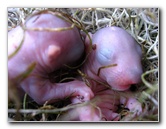 "Pinkie" Baby Squirrels |
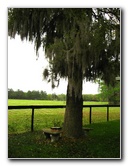 Oak Tree & Spanish Moss |
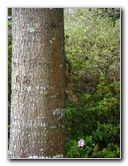 Mother Squirrel? |
|
This past weekend my brother found a nest with a trio of baby squirrels
inside his home's rain gutters. The infants had to be removed since a
roofing company was coming in a few days to tear up the old shingles and
lay down new ones. We tried to re-unite the babies with the mother squirrel by placing them in a shoe box lined with Spanish moss and a hot water bottle at the base of a large Oak tree where she had previously been seen. From inside the house we quietly watched a squirrel we thought might be the mother come within a few feet of the babies. I read online that if the mom doesn't claim her offspring within a few hours that they could be considered abandoned. Unfortunately, after 8 hours the sun started to set, the temperature outside began dropping rapidly and the mother had not yet retrieved the baby squirrels. |
||
|
|
||
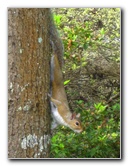 Male Squirrel Predator? |
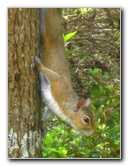 Eastern Gray Squirrel |
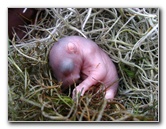 Dehydrated & Cold |
|
The pictures above of the adult squirrel were taken inside the house from a distance using both the optical & digital zoom features of my Canon S5 IS digital camera. I think the mother may have been spooked by the construction crew nearby who were building new houses in the neighborhood. From my internet reading I knew that we shouldn't leave the infants out over night in the cold where they might be taken by predators. The mother's activities cease once the sun goes down so it was pointless for them to remain outdoors if she wasn't going to come pick them up. |
||
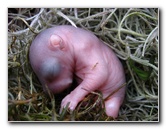 Light Grey Hair Fuzz |
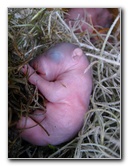 Pink Bellies & Closed Eyes |
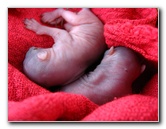 Ears Developing At 2 Weeks |
| Since I have some
experience with animal care from working at veterinarian's office during
high school, I was elected to spearhead their treatment, care and
maintenance.
My brother made a few calls during the day and we were just waiting for a call back from the local squirrel "rehabber". I had done some thorough online reading about baby squirrel care while we waited for the mom to hopefully take her children back to a new nest. So once we brought them inside I took out the Spanish moss from the cardboard shoe box, laid down some shop towels, and heated up two water bottles wrapped in more towels. I immediately noticed a positive improvement in their behavior once the babies were warmed up. The next step was to get them re-hydrated. We purchased a bottle of the unflavored CVS brand generic pediatric electrolyte oral hydration maintenance solution for $3.58 (it was $5.38 for the Pedialyte brand). We asked the pharmacist for a pediatric oral syringe and she gave us one for free once we explained the situation. |
||
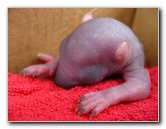 Hairy Head & Claws |
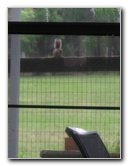 Mom?, Infants In Box |
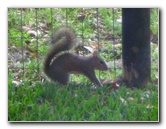 Eating Before Sunset |
| I performed a "turgor
test" to see how dehydrated they were by very gently pinching the skin
between their shoulder blades.
The skin was slow to move back in place, a sign of severe dehydration, but started snapping back quickly as the salt, sugar and water in the generic Pedialyte replenished their little bodies. The baby squirrels were also very lethargic at first but began to significantly perk up as we offered them a few drops of the warm plain electrolyte solution every hour for the first 12 hours. I read that Gatorade, Powerade or other sports drinks are not good substitutes because their sugar content is excessively high and may cause diarrhea and further dehydration. If you can't obtain Pedialyte, or a generic store brand, it's possible to mix up an acceptable homemade electrolyte solution. I came across two recipes with one of them being simpler than the other. The simple recipe called for one (1) teaspoon (tsp) of salt, three (3) teaspoons of sugar and 1 quart (qt) of water. The more complex concoction included one half (1/2) teaspoon of baking soda, 1/2 tsp of potassium salt, 1/2 tsp of table salt, 3 tsp of sugar and 1 liter (L) of water. |
||
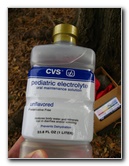 Generic CVS Pedialyte |
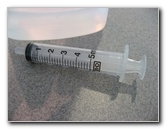 5ml / 5cc Oral Syringe |
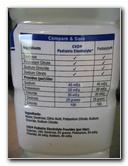 Pediatric Electrolyte Solution |
|
Now that the baby squirrels were warmed up to their preferred body temperature of about 99 degrees Fahrenheit and were fully re-hydrated, we visited a pet store to find a suitable formula. The two formulas that I saw mentioned most often as being suitable were Esbilac Puppy Milk Replacer and Milk Matrix Zoologic formula for exotic animals. The local Petco had the Esbilac liquid in stock but not the powder mix, which I read the professional rehabbers strongly prefer. (Buy the powdered version if you can find it!) It was $4.99 for an 8 ounce (oz) can, which must be kept refrigerated after opening and discarded 72 hours later. Using a few squirrel age charts online, I determined that the babies were somewhere around 2 weeks of age since they had hair coming in on their heads, a visible umbilical cord and their ears were almost developed. The recommended dosage of formula for each feeding (every 2-3 hours) varied from .5cc to 2cc depending on the exact age or weight of the baby. We had also purchased a nursing bottle with rubber nipples but then I later learned that a bottle could lead to the babies aspirating the formula into their lungs and cause pneumonia. A smaller 1cc-3cc O-ring syringe would have been the best feeding device for babies this size but everything went well being careful with the 5cc/5ml oral syringe with rubber plunger we got for free from the CVS pharmacy. |
||
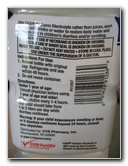 Re-hydrate Before Feeding |
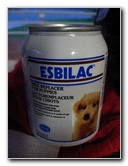 Esbilac Formula |
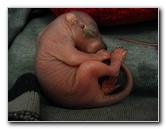 Re-Hydrated & Warm |
| Before feeding the
babies for the first time I decided to try checking to see if they needed to
relieve themselves by eliminating waste (a.k.a. pee & poop
Some of the techniques I read about included using either dry or wet QTips, cotton balls, Kleenex tissues, or toilet paper to gently tickle their genitals. I knew that I'd have to be patient with this process since I had read it could take as long as two minutes of light feather strokes to get them to release some urine and/or feces. Luckily all three of them went to the bathroom very quickly which alleviated any concern of uremic poisoning. I found that Q-Tips dampened in warm water worked the best of all the methods we attempted. |
||
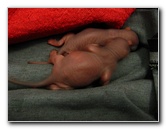 Snuggling Hot Water Bottle |
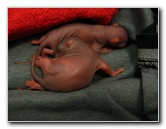 Crawling & Active Babies |
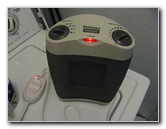 Hand Warmer / Space Heater |
| After reading all
of the different opinions about what was best to feed the baby squirrels, I
was glad we were able to find Esbilac since most of the squirrel
rehabilitation websites recommended it.
One authoritative site pleaded that we avoid the "scalded milk recipe", any variety of cow milk, human baby formula, Hartz Kitten Milk, evaporated milk, raw egg and Mother's Helper. They said that the Esbilac was the closest thing to the mother squirrel's own milk with the proper amounts of fat, vitamin D, and calcium. An improper diet that lacks calcium or vitamin D, which is necessary to absorb the calcium, at this young of an age can lead to Metabolic Bone Disease. MBD is a common condition in malnourished baby squirrels. |
||
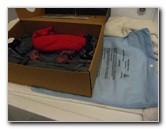 Half Box On Heating Pad |
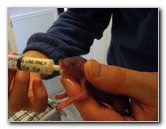 Feeding Very Slowly |
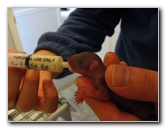 ~ 1 cc/ml Every 2-3 Hours |
| The first feeding
of Esbilac formula wasn't very confidence inspiring because the babies
didn't consume more than a few drops each.
With each subsequent feeding the baby squirrels showed more life, had a stronger grip on my fingers, squirmed more in my hands, and crawled around the shoe box for a longer period of time before falling asleep. I was afraid to overfeed them and cause bloat, aspiration or pneumonia so I applied gentle pressure on the syringe's plunger, paused often to wipe their noses, and limited the amount of formula to anywhere from 1/2cc to 1cc per infant. I held the babies in the same position as I had seen in pictures on the wildlife rehabber sites. They mentioned that you should never feed a baby on it's back since they could choke on the formula. The few times that I noticed a bubble coming out of one of their nose's, I immediately held the baby with it's face down to let any fluids drain out. |
||
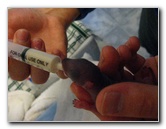 Better Appetites Each Time |
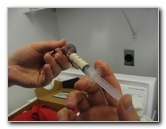 Careful To Avoid Aspiration |
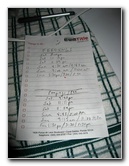 Feeding/Elimination Schedule |
| We kept a schedule
of the feeding times and also the waste eliminations to make sure that the
babies were not being over or under fed.
Another reason for the schedule was to help give the wildlife rehabilitation expert an idea of how the infants had progressed over the two days that they were in our possession. Even though it was unfortunate that the nest had to be disturbed because of the roofers, it was lucky that the nest had not been attacked by other animals or that the babies had not fallen to the ground. The babies were clean with no fleas, maggots (fly larvae), injuries, scratches or cuts (which would have had to been treated with a diluted hydrogen peroxide solution and Neosporin antibacterial cream). We're also lucky that none of the neighborhood cats got a hold of the infants while they were waiting at the base of the tree for the mom to retrieve them. I've read that a cat bite could infect squirrel babies with a bacteria in their saliva called "pasturella" which would require antibiotics within 12-24 hours or they could suffer central nervous system damage. |
||
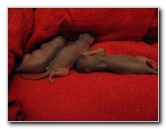 Content & Sleeping |
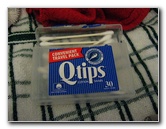 Cotton Q-Tips Bathroom Aids |
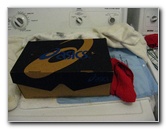 Ventilated Sneaker Box |
| Late on Sunday
afternoon, the local certified wildlife rehabilitation person called us back
and came over to pick up the babies.
She said we were some of the best squirrel baby foster parents she has ever dealt with. She said that the infants seemed to be doing well and that they had a high chance of survival. She was glad that there were three of them since a single orphaned baby squirrel wouldn't receive the socialization necessary for a successful future release back into the wild. To discourage the mother from building her next nest in the gutters again, my brother is considering removing the gutter guards which form an attractive shelter. The average eastern grey squirrel can have two litters per year (spring & summer). Hopefully next time she'll build a "drey" (a nest on tree branches) or a "den" (a nest in a tree cavity) rather than somewhere on the house. If you'd like
to see some more wildlife check out my other updates such as the
San Diego Zoo,
Flamingo Gardens,
Maine Whale Watching,
Florida Everglades Airboat Ride,
Everglades Holiday Park Alligator Wrestling,
Yorkie Puppy,
Parakeets,
Banana Spider & Wasps, and the
Carpenter Bees. |
||
| If you found this guide to be helpful,
please consider making a small donation by clicking on the PayPal.com
"Donate" button located to the right of this paragraph. Thank you!
(Note: I am not a registered charity. Donations are not tax deductible.) |

